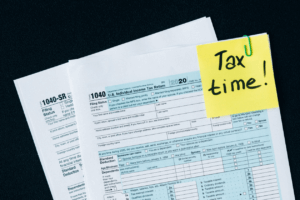What you need to know about tax extensions and new tax rules
What you need to know about tax extensions and new tax rules
Many taxpayers will not file their 2022 tax returns by the April 18, 2023 deadline. Done properly, such taxpayers can receive a six-month extension of time to file and avoid any interest charges or penalties from the IRS. What does “done properly” mean, what are the benefits and downsides of an extension, and should you extend your tax return this year?
For answers, we turn to our Tax Manager, Kevin McDermott, CPA, to explain how extensions work.
“When the April 18 tax deadline comes around this year, many of us will still be scrambling to wrap up our tax return. Whether it’s because of corrected 1099s, a late-arriving partnership K-1, compiling charitable contribution receipts from last year, or a myriad of other things, just getting everything together can come down to the wire. If you prepare your own tax return, anxiety around filing on time could be weighing on you for months. If you give your documents to a tax preparer, they’ll want those documents as early as possible to have sufficient time to prepare and review your return. Either way – when life gets busy – you might not have enough time to file your taxes.
The IRS lets you extend that tax deadline by six months to October 16. What’s the catch? The extension gives you six more months to file the return, but it doesn’t give you six more months to pay the tax due. Even if you have not completed your return, you still need to pay any remaining balance due on your 2022 taxes by that April 18 deadline as an extension payment.
For those whose income mostly comes from employment, taxes are withheld throughout the year from each paycheck, and if enough was withheld, you wouldn’t expect to make another large payment in April.
For taxpayers who have other income where no taxes are withheld (such as a self-employed business, large amounts of investment income, or a K-1 from a profitable partnership or S Corporation), payments are required to be made via quarterly estimated tax payments. If those estimated tax payments cover the full tax liability for the year, no payment will be required with the return or extension in April.
If you do think more tax will be due with your return, you can make the extension payment by April 18. The IRS is happy as long as 
So, is an extension right for you? If you already have all your documents ready in February and you’re itching to see that refund in your bank account, there’s no reason to wait – go ahead and get it filed! But if you know documents may come in later, or if you want more time to make sure your return is done correctly, there’s very little downside to filing an extension.”
New tax rules for retirement plans
On December 29, 2022, President Biden signed into law the Consolidated Appropriations Act 2023. Among its 4155 pages, 359 address changes to tax law surrounding retirement plans. This section is collectively referred to as SECURE Act 2.0 because it contains several items the drafters of the original SECURE Act did not get passed in 2019. The new law adds many more provisions that are now in place or will become effective over the next several years.
This is an extensive piece of legislation aimed at retirement plan reform. Unfortunately, the one thing it did not do is simplify the rules surrounding retirement plans. We will highlight a few of the most prominent changes that will affect many of our clients. We’ve separated them into two categories: new rules for those saving for retirement and new rules for those aged 70 and older.
New rules for those saving for retirement
A major theme of the savings provisions in SECURE 2.0 is expanding the use of Roth IRA accounts.
Starting in 2023, employers can deposit their matching or nonelective contributions to employees’ designated Roth accounts in plans such as a 401(k) or 403(b) plan. Those Roth deposits will not be subject to a vesting schedule so employees will take that with them should their employment end. However, the matching Roth deposits will be taxable income to the employee in the year of contribution.
Few clients will be able to take advantage of this immediately for several reasons. First, many employers do not offer a matching contribution at all. Second, some employers will not like the lack of a vesting schedule. Third, paying tax while employed to fund a Roth account is often an inferior strategy to pre-tax contributions and fourth, plan administrators must amend their plan documents to accommodate matching deposits to a Roth account.
Few clients will be able to take advantage of this immediately for several reasons.
Nonetheless, for clients who are in lower marginal tax brackets now and whose employers will make the needed changes, Roth matches are a new tool.
In addition to the new Roth matching money, SECURE Act 2.0 authorizes the creation of both SIMPLE Roth accounts, as well as SEP Roth IRAs. Previously, SIMPLE and SEP plans could only include pre-tax funds. So, for those for whom a SIMPLE or SEP plan is appropriate, choosing a Roth is now an option but as with the Roth 401(k) matches just mentioned, rapid implementation is not likely.
SECURE 2.0 increases somewhat the ability to tap a retirement account prior to age 59 ½ in 2023 but only under dire circumstances. If your plan allows and you are in a time crunch, employers can process a hardship distribution based upon “self-certification” rather than waiting for the employee to provide evidence of the hardship. Taxpayers exercising this new option should still document their evidence in case of audit.
In addition, if your doctor expects you will pass away in the next seven years, you may be eligible to access your funds penalty-free regardless of your age. Normal taxes would still apply. Over the next several years, SECURE 2.0 will also increase the number of situations for which the 10% early distribution penalty will be waived. The penalty normally applies to distributions from retirement plans by those aged 59 ½ or younger.
Beginning in 2024, SECURE Act 2.0 creates a massive change to catch-up contributions for certain high-income taxpayers participating in 401(k), 403(b), and governmental 457(b) plans. Employees with wages in excess of $145,000 (which will be adjusted for inflation in the future) in the previous calendar year would only be permitted to make those catch-up contributions to a Roth account. This forces such employees to use after-tax income to fund their catch-up contribution.

These new Roth catch-up requirements do not affect IRA and Roth IRA accounts. Beginning in 2024, however, IRA/Roth IRA catch-up contribution limits will finally be subject to automatic inflation adjustments. The IRA/Roth catch-up limit has been stuck at $1,000 for many years.
There is another catch-up provision that goes into effect in 2025. It offers an enhanced catch-up amount but is rather odd in that it is only applicable to persons aged 60-63. We’ll cover this sometime before 2025.
Section 327 of SECURE Act 2.0 will extend the list of options for spouses who inherit IRAs and retirement accounts. Starting in 2024, a spouse inheriting such accounts will have the ability to elect to be treated as the deceased spouse. We will cover the pros and cons of doing that in a future post.
The last item we will highlight is a new ability to rollover unused 529 college savings plans into Roth IRAs starting in 2024. The 529 accounts must be at least 15 years old, and the rollover amount is limited but it makes for an interesting option.
New rules for those aged 70 and older
Headlines state that the starting age for Required Minimum Distributions (RMD) is going to 73 or 75. The calculation methodology has not changed for anyone, just the starting age for some.
To keep it simple, if you were born in 1950 or earlier, you became subject to a RMD in 2022 and are not affected by the new rules. If you were born between 1951 and 1959, your RMD begins when you turn 73. If you were born in 1960 or later, your RMD begins when you turn 75.
To keep it simple, if you were born in 1950 or earlier, you became subject to a RMD in 2022 and are not affected by the new rules. If you were born between 1951 and 1959, your RMD begins when you turn 73. If you were born in 1960 or later, your RMD begins when you turn 75.
As was the case with the SECURE Act of 2019, while the starting age for the RMD was increased, there was no change to the date individuals can make Qualified Charitable Distributions (QCDs) from their IRA accounts. QCDs can be made anytime on or after the date a taxpayer turns 70 ½. QCDs will continue to count toward the RMD. The only change SECURE 2.0 made to QCDs was to index for inflation the $100,000 maximum annual total of QCDs made in a given year beginning in 2024.
Also related to RMDs, beginning in 2023, the 50% penalty for an RMD shortfall is reduced to 25%. If the shortfall is from an IRA and rectified within the “Correction Window,” then the penalty is further reduced to only 10%. The “Correction Window” begins when the penalty is imposed, generally on January 1 of the year following the year of the missed RMD. The correction window ends upon the earliest of when the tax is assessed by the IRS, when the Notice of Deficiency is mailed to the taxpayer, or the last day of the second tax year after the tax is imposed.
In other words, to get the reduced penalty, it is better for the taxpayer to discover the shortfall and correct it before the IRS sees that the RMD was not met.
In the past, because the penalty was so stiff and affected an older demographic, it was common to get the penalty waived. Many commenters say that reducing the penalty and providing an even lighter penalty for timely corrections is a sign the IRS will more vigorously enforce penalties for missing RMDs. We track RMD compliance diligently, so our clients need not be concerned about RMD shortfalls.
More to come
We left out a lot of other provisions that will come online in future years from SECURE 2.0. Rest assured we will keep you informed of these changes as they become relevant and actionable. In the meantime, we are here to help you determine which of these provisions will affect you and how they affect your plans.

